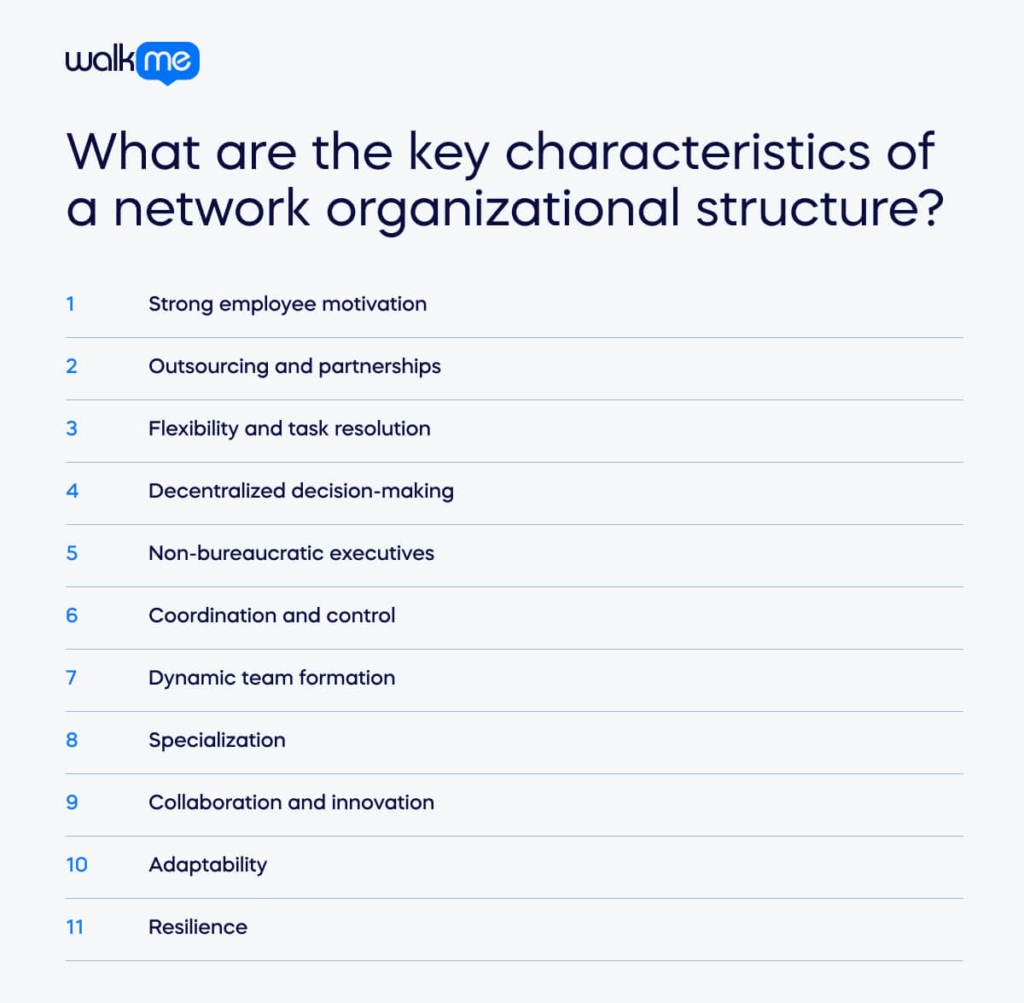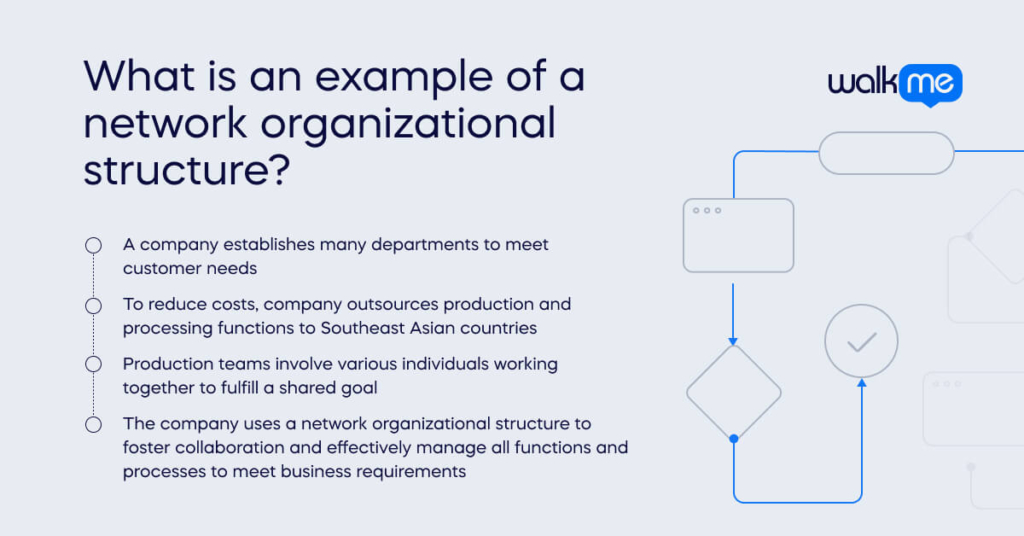As the business world undergoes constant transformation, traditional hierarchies often struggle to keep up. This has fueled a shift toward more adaptable systems, with the network organizational structure emerging as a dynamic model for the digital age.
Characterized by agility and flexibility, network structures empower organizations in fast-paced markets to respond quickly. They break away from rigid hierarchies, fostering collaboration among internal teams and external partners. This wider network enables access to diverse expertise and resources, improving efficiency and tackling complex projects more effectively.
Unlike traditional models, network structures encourage open communication and knowledge sharing. The free flow of information supports innovation and smoother change management, ensuring transitions are handled with less disruption.
This article defines the network organizational structure, explores its characteristics and forms, and presents a real-world example. We’ll also share best practices for implementing a network structure successfully.
What is a network organizational structure?
The network organizational structure groups employees according to their specialization, promoting collaboration on various projects with specialists throughout the organization.
For example, a company may have dedicated teams for customer service and public relations. When new projects arise, team members can collaborate on them.
Ad-hoc business units or local offices can collaborate in networked organizations. These organizations meet customer needs by leveraging the entire organization’s resources, avoiding rigid workflows and reporting relationships.
In networked organizations, the executive team streamlines operations by focusing on the broader organization’s structure and important decisions. The company’s network relies on individual pods to manage day-to-day operations.
What are the key characteristics of a network organizational structure?

Here are the main characteristics of a network organizational structure:
Strong employee motivation
The success of networked organizations relies on motivated employees. Each team member needs strong internal motivation to complete their tasks, as there is little direct supervision from management.
Incentives, such as upskilling, recognition programs, and growth opportunities, can help. Communicating their individual responsibilities also helps them understand their impact on the organization.
Outsourcing and partnerships
Networked organizations use outsourcing to gain access to skills they lack. This strategy enables companies to stay agile and cost-effective.
A company could, for example, delegate its customer service to a specialized firm or collaborate with a marketing agency for a major campaign. This strategy empowers organizations to concentrate on their key strengths while relying on external resources for specialized requirements.
Flexibility and task resolution
Companies can use the flexibility of the network model to organize teams. Teams can assess their tasks and select the most efficient methods to achieve their goals.
The organization’s flexibility allows it to form a team of experts for any project, enabling it to respond to market changes and evolving customer needs, keeping it competitive.
Decentralized decision-making
In a network structure, there are fewer hierarchical levels and a wider span of control. Decision-making and ideas flow from the bottom up.
This decentralized method allows everyone to understand their responsibilities and what management expects, promoting faster decision-making and innovation throughout the organization.
Non-bureaucratic executives
Empowered leaders strive to reduce unnecessary bureaucracy and excessive control, giving more autonomy to individual network entities. Adopting this approach enables a lean management structure and fosters a culture of trust and empowerment among employees, allowing executives to concentrate on high-level decisions.
Coordination and control
While networked organizations may lack standardized rules, you can establish specific objectives for every team or project.
Regular performance monitoring is crucial for keeping teams on target. Rewarding results with leadership development or promotions helps reinforce positive behaviors and outcomes. The aim is to synchronize individual and team efforts with the organization’s goals.
Dynamic team formation
Small, specialized teams with the right skills are a key feature of this structure. The company can realign them for new goals after completing tasks, ensuring operational efficiency and providing employees with diverse and challenging work opportunities.
Specialization
The network’s different entities specialize in specific functions or tasks, enabling the organization to leverage its diverse talents to address various challenges. The organization groups employees with similar specializations when a new project arises.
For example, a marketing campaign might involve digital marketers, graphic designers, and content creators working together. This structure fosters cross-functional collaboration.
Collaboration and innovation
The network organizational structure boosts collaboration and innovation by breaking down traditional silos and fostering cross-functional teamwork. Sharing unique perspectives and expertise across departments can lead to more effective solutions. The collaborative environment promotes continuous learning by exposing employees to fresh ideas from their peers.
Adaptability
Network organizations excel at adapting to change. They can seize new opportunities due to the network model’s flexibility. You can rearrange teams in response to regulatory or technological changes, providing a major competitive advantage.
Resilience
The network organizational structure also contributes to building a resilient business through decentralized decision-making.
Each team in the network can make its own decisions, allowing the organization to remain operational even if one part does not function well. This resilience is critical in times of crisis, enabling the organization to continue delivering value to customers despite challenges.
What are the types of network organizational structures?

The different network organizational structures are:
Agile network
A key feature of a network structure is that members come together for a specific task and then disband once it’s completed. A common practice is to form project teams comprising employees from different units who work together on a project before returning to their respective teams.
Correlated network
A correlated network refers to different departments collaborating to meet shared goals, with a common interest in certain business aspects. For instance, motorbike manufacturers have many product lines but collaborate on supply chain management and technology development.
Contract network
In a contract network structure, the company has formal agreements with independent partners. These might encompass franchises, concessions, or other agreements to achieve mutual business goals. Each partner functions independently while adhering to the established agreement.
Market network
The structure of a market network organization revolves around various market segments. For example, a company might have distinct departments for men’s and women’s sportswear. Both will produce products for their specific target audiences, collaborating to meet the diverse needs of customers.
Product network
Product lines determine the organization of members in a product network organization. For instance, a company could have separate divisions for perfumes and candles, each with the goal of promoting products within their specific area.
Functional network
Members in a functional network organization organize themselves according to their specific roles. Departments work together to achieve the company’s goals, including marketing, finance, and customer service. The focus is on fostering collaboration between specialized teams.
Integrated network
An integrated network within an organization is a structure where different units collaborate and share information, resources, and processes. Examples include a food chain with many store locations or an engineering company with several factories.
What is an example of a network organizational structure?

Here is one example of how you could use the network organizational structure:
A clothing company establishes many departments to meet customer needs. To reduce costs, it outsources production and processing functions to Southeast Asian countries. Maintaining relationships with suppliers in Asia can also help keep costs low.
Production teams involve various individuals working together to fulfill a shared goal. These individuals could be research and development heads, production managers, or marketing executives. Through a network organizational structure, the company can create a collaborative work environment and manage all functions and processes to meet business requirements.
Best practices for implementing a network organizational structure

The network organization’s fluid structure leads to a larger web of relationships, which may diminish the clarity of accountability lines.
This could lead to a greater dependence on external vendors. These unpredictable factors can reduce the core company’s control over its operations. Thus, it is crucial to have best practices for implementation.
These best practices could include:
Choose the right external partners
Picking the right partners is vital for an effective network structure. Ensure your partners match your organization’s values, culture, and long-term objectives. Aligning goals cultivates unity and a shared vision.
This leads to more effective collaboration. A strong organizational culture facilitates smooth communication and mutual understanding, resulting in effective cooperation and successful project outcomes.
Selecting partners well mitigates the risks of poor performance or non-compliance. Collaborate with partners who focus on quality and ethical standards.
Performing extensive due diligence can guarantee the selection of reliable and trustworthy partners.
Diversify and balance network partners
Trusting external partners with aspects of your business can open you up to risks, including concerns about their performance, availability, or reliability.
To address this, having a diverse and balanced set of network partners is crucial. Having many partners for a function reduces the risk of disruption in the event of one partner’s failure.
Identifying and building relationships with many trustworthy partners is key to achieving diversification. Assess your network regularly to maintain its balance and resilience. Avoid relying too much on one partner to maintain business continuity.
Establish clear goals, roles, and expectations
Coordinating activities among different departments is a major obstacle in a network structure. Network members may experience confusion, inconsistency, duplication, conflict, and decreased accountability and quality.
Start by defining clear and consistent expectations for each network associate.
Well-defined goals foster a collective understanding of purpose and direction, reducing task overlaps that can result in inefficiencies. Detailed operational manuals and regular employee training sessions can also communicate each partner’s obligations.
Regular monitoring and evaluation of partner performance is crucial for upholding high standards. Conducting performance assessments helps identify problems early and allows for corrective action. A structured performance evaluation system enables continuous improvement and accountability network-wide.
Create effective communication and feedback mechanisms
The effectiveness of a network structure relies on strong and efficient communication systems. Open communication channels foster alignment and enable rapid obstacle resolution.
They also sustain a unified vision within the organization. Effective communication mechanisms, like real-time data-sharing tools, allow interaction among network members.
Invest in advanced IT that enables real-time data sharing, allowing partners to access current information and make prompt, informed decisions. Nurturing a culture of openness enables partners to address concerns.
Feedback mechanisms are crucial for maintaining continuous improvement. Partners can use regular feedback sessions to share experiences and suggest improvements. Constructive feedback plays a crucial role in pinpointing areas for improvement and cultivating a learning culture within the network.
Establish and enforce clear contracts
Managing relationships in a network organization requires clear and fair contracts. These contracts should establish the roles, responsibilities, and expectations for each partner, including performance metrics and consequences for failing to comply. Effective partnerships rely on well-drafted contracts that prevent misunderstandings and disputes.
Enforcing clear contracts is vital. Conducting routine audits and performance evaluations ensures that everyone follows the established terms. Predefined mechanisms like renegotiation or termination clauses can ensure network integrity and performance.
Protect intellectual property and confidential data
Protecting intellectual property and confidential data is crucial in a network structure. Safeguard your information by implementing robust security measures, including data encryption, access controls, and regular security audits.
Ensure partners protect your data by adding confidentiality clauses to your contracts. Review and address emerging threats to keep your security policies up to date, reducing the chances of breaches and maintaining network trust and integrity. Implement proactive measures to protect your intellectual property and confidential data.
Foster trust and cooperation
Trust and cooperation are vital for a successful network organizational structure. Building trust promotes open communication, minimizes conflicts, and strengthens collaboration. Develop trust by practicing transparency, upholding commitments, and encouraging partners to follow suit.
Strengthen relationships by providing opportunities for partners to interact and collaborate, such as job rotation or other team-building activities. Compensating partners for their efforts reinforces positive actions and cultivates a collaborative environment.
Assess partner performance
Considering partner performance is crucial for ensuring quality, accountability, and continuous improvement. Develop clear metrics that align with your strategic objectives and use these to check your partners regularly.
Performance assessments should cover various aspects, including quality of work, adherence to timelines, and compliance with contractual obligations.
This ongoing monitoring enables early identification of potential issues and offers opportunities to provide constructive feedback or renegotiate terms if required. Regular performance reviews also help reinforce expectations and encourage continuous improvement among partners, ensuring that your network remains strong and effective.
Key takeaways of a network organizational structure
The network structure differs from traditional structures. It is less hierarchical, more decentralized, and more flexible. Managers in this structure oversee internal and external relationships within the company.
Open communication and dependable partners are essential elements of these networks. Their decentralized nature reduces hierarchical tiers and allows decision-making from the bottom up, providing flexibility that allows organizations to adapt to changes and seize opportunities.
Yet, the network structure can give rise to more complex relationships. Creating an effective implementation plan demands careful attention to several crucial areas.
The first step is to select the right partners. To prevent confusion and inefficiencies, establish clear goals and roles. You should have effective communication channels in place for alignment and information sharing.
Diversifying partners is essential for stability and reducing vulnerability, as it helps avoid over-reliance on any one entity. It is crucial to have strong contracts that outline responsibilities and expectations.
Safeguarding intellectual property and sensitive information is crucial, particularly when collaborating with external partners. Regular evaluations uphold high standards and contribute to ongoing growth.
Establishing an effective organizational network promotes trust and cooperation among its members.

Common Questions
By enabling agile, cross-functional pods, it allows seamless integration of new digital tools, faster feedback, and iterative deployment—critical for enterprise-scale change initiatives.
It empowers teams closest to challenges to act swiftly, fostering innovation and resilience—especially important in rapidly changing markets or during transformation efforts.
Consider shifting when facing multi-disciplinary, fast-paced projects or when responsiveness and innovation have become strategic priorities.
Leverage internal pods and reassign tasks to alternate specialists or partners, maintaining continuity through network flexibility and resilience.

